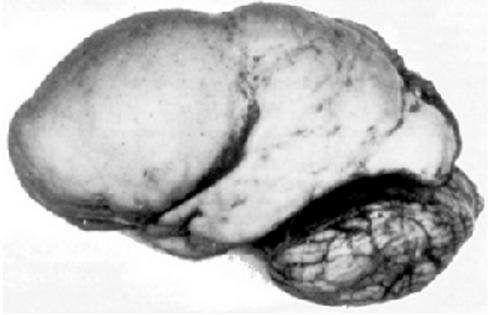Polymicrogyria (PMG) is a developmental malformation of the human brain characterized by an excessive number of small convolutions (gyri) on the surface of the brain. Either the whole surface (generalized) or parts of the surface (focal) can be affected.
Clinical presentation
The diagnosis of PMG is merely descriptive and is not a disease in itself, nor does it describe the underlying etiology or cause of the brain malformation.
Polymicrogyria may in fact be just one piece of a syndrome of developmental abnormalities, because children born with it may suffer from a wide spectrum of other problems, including: global developmental disabilities, mild to severe mental retardation, motor dysfunctions including speech and swallowing problems, respiratory problems, and seizures. Though it is difficult to make a predictable prognosis for children with the diagnosis of PMG, there are some generalized clinical findings according to the areas of the brain that are affected.
- Bilateral frontal polymicrogyria (BFP)-Cognitive and motor delay, spastic quadriparesis, epilepsy
- Bilateral frontoparietal polymicrogyria (BFPP)-Severe cognitive and motor delay, seizures, dysconjugate gaze, cerebellar dysfunction
- Bilateral perisylvian polymicrogyria (BPP)-Pseudobulbar signs, cognitive impairment, epilepsy, some with arthrogryposis and/or lower motor neuron disease
- Bilateral parasagittal parieto-occipital polymicrogyria (BPPP)-Partial seizures, some with mental retardation
- Bilateral generalized polymicrogyria (BGP)-Cognitive and motor delay of variable severity, seizures
Diagnosis

With increased use of imaging techniques such as MRI and CT, polymicrogyria is becoming more widely diagnosed.
Pathology

Polymicrogyria is a disorder of neuronal migration resulting in structurally abnormal cerebral hemispheres. The Greek roots of the name describe its salient feature: many [poly] small [micro] gyri (convolutions in the surface of the brain). It is also characterized by shallow sulci, a slightly thicker cortex, neuronal heterotopia and enlarged ventricles. When many of these small folds are packed tightly together, PMG may resemble pachygyria (a few "thick folds" - a mild form of lissencephaly).
Etiology

The etiology of polymicrogyria is unclear. It is currently classified as resulting from abnormalities during late neuronal migration or early cortical organization of fetal development. Evidence for both genetic and non-genetic etiologies exists. Polymicrogyria appears to occur around the time of neuronal migration or early cortical development. Non-genetic causes include defects in placental oxygenation and in association with congenital infections, particularly cytomegalovirus.
An association with the gene WDR62 has been identified.

